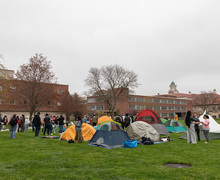Smith: Human creativity and imagination will forever separate man and machine
Welcome to the Information Age, where people have been conditioned to share every thought online and treat their digital identities as true representations of themselves. It’s either the most exciting or the most frightening time to be alive, depending on your disposition.
One-seventh of the world’s population are now users on Facebook, and the line between man and machine has grown ever thinner as roughly six billion people now carry a cell phone, of which nearly two billion are smartphones.
In an age made, molded and mediated by machines, it is now more important than ever to define and reclaim our humanity.
We’re beginning to understand our relationship with technology as not just a means to an end but a complete submersion into a way of life that has given us the means to reach thousands of people while simultaneously denying us substantive human connections.
We can be supplemented with prosthetic limbs, synthetic skin, artificial hearts and even implanted with chips to make up for our biological weaknesses. Now that biotechnology has helped us overcome the obstacles that once stood in the way of our survival, it’s no longer possible to define our species as completely organic.
The fusion between man and machine has become so commonplace that trans-humanism is now a cultural norm rather than a science fiction fantasy. We’re undergoing an evolution within our species that has changed the way we live, work and interact with each other on a daily basis so significantly that our identities have become limited to our data streams.
The philosopher Immanuel Kant defined a human being by three criteria. The first was a technical disposition for manipulating things. The second was pragmatic desire to use other things and human beings for one’s own purposes.
We see these first two criteria being leveraged constantly in the digital age as we tinker with our gadgets and hackers continually exploit the most vulnerable part of any operations system, the human link, through tricks of social engineering.
Thus, this third criterion becomes the most important because it is the most distinctly human— our desire for morality and the compassion that urges us to seek out ideals like freedom, justice and equality for all people.
Morality in particular is not something that can be programmed, as even in the human world we are perpetually shifting our stances on issues as new facts and circumstances become apparent.
Joseph Weizenbaum, the German author and Massachusetts Institute of Technology professor, once said that he felt the only jobs a robot shouldn’t be allowed to do are those that require man’s unique talents for respect and care, such as customer service representatives, psychiatrists and judges.
Yet we’ve already seen automated voice recordings take over the bulk of telephonic customer service interactions, much to the annoyance of human customers, and there is some credence to the fear that we are ushering in our own extinction.
But above all, the trait that separates us most from our beloved machines is our endless capacity for creativity and imagination.
Although engineers are currently working on robots that can create abstract works of art and have higher states of consciousness, our technology will always be limited by how far we can stretch our own imaginations.
It’s a brave new world out there and although we have no choice but to continue on the path of progress toward an increasingly techno-dependent culture, we must also remember not to treat each other solely as systems of data but the intelligent, intuitive and imaginative creatures that we are.
Kat Smith is a senior creative advertising major. Her column appears weekly. She can be reached at [email protected] or by telepathy, if possible.
Published on January 14, 2013 at 2:10 am




